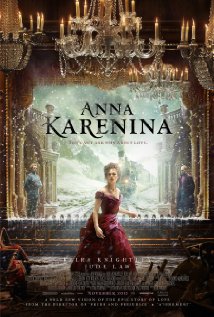 This is the fifth in a series of six posts on the 2013 Oscar nominees for Best Original Score. After discussing each of the five nominees in separate posts, the sixth post will give my prediction for the Oscar winner and my reasoning behind it.
This is the fifth in a series of six posts on the 2013 Oscar nominees for Best Original Score. After discussing each of the five nominees in separate posts, the sixth post will give my prediction for the Oscar winner and my reasoning behind it.
Dario Marianelli has been scoring films for nearly two decades and although he has written for such diverse films as The Brothers Grimm, V for Vendetta, and Eat, Pray, Love, he has in recent years gained something of a reputation for scoring period dramas. In 2005, his score for Pride & Prejudice was nominated for an Oscar, and only two years later, his score for Atonement won the coveted prize. He also scored Jane Eyre in 2011 and won his second Oscar nomination with 2012’s Anna Karenina.
Marianelli’s score for Anna Karenina is set almost entirely in a nineteenth-century style in terms of the orchestration’s focus on the strings, the familiar tonal chord progressions, and the operatic and lyrical melodic lines. As Cary Fukunaga (director of Jane Eyre) says of Marianelli, “Dario has a really amazing talent for melody and creating melody that, through the course of the film, becomes synonymous with the emotional experience of the characters.” It is no surprise, then, that it is the melodic lines that dominate Marianelli’s score for Anna Karenina.
In most film scores, themes (or more properly, leitmotifs) usually identify a character, place, object, and so on, through a short snippet of melody. This snippet may be part of a longer theme, but all we need to make the association is the theme’s opening. In Anna Karenina, it is still true that the opening of a theme makes the association, but the themes are generally stated as a full eight-bar, sixteen-bar, or larger structure whenever they are heard. Consequently, many statements of themes begin or continue to play even when its associated character, place, object, etc. is not literally present onscreen. While this tactic makes the association significantly looser and more difficult to interpret than in most other films, it is well suited to the nineteenth-century setting of the narrative. Below, I take a close look at the main themes that pervade this score.
“Anna’s Love”
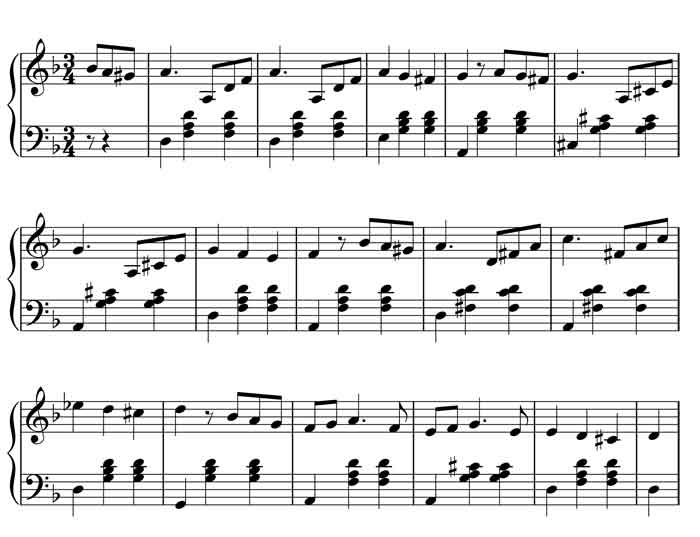 This is the most prominent theme in the score as it is heard more often than any other. It would be easy to simply consider this “Anna’s Theme”, but a close inspection reveals that it is generally associated with Anna’s love, not only for her lover Count Vronsky, but also for her son Serozha. A couple of key scenes demonstrate this.
This is the most prominent theme in the score as it is heard more often than any other. It would be easy to simply consider this “Anna’s Theme”, but a close inspection reveals that it is generally associated with Anna’s love, not only for her lover Count Vronsky, but also for her son Serozha. A couple of key scenes demonstrate this.
At the dance where Anna first meets Vronsky, this theme begins as we see a young adolescent boy take Princess Kitty to dance. Although this may seem an incongruous association with the music, the theme starts here because it is partly “diegetic” or “source” music that takes place in the narrative world and that the characters actually hear. In other words, this is the music they are dancing to, and since it is the dance during which Anna and Vronsky will fall in love, we hear “Anna’s Love”. The melody of this theme quickly moves on to different material (from Tchaikovsky’s Swan Lake waltz) while Kitty and the boy dance. But when Anna accepts Vronsky’s invitation to dance, the melody makes a striking return, now clarifying the association between the music and Anna’s love. And when the background lighting darkens and a spotlight shines on Anna and Vronsky to emphasize their new-found love, the scoring of the theme thins out and we hear a solo violin play the melody—a traditional symbol of romantic yearning in film scores. Because of the pivotal role this dance plays in Anna’s life, her love theme generally retains its waltz-like three-beat measures throughout the film. It is also always heard in a minor key to denote the tragic part Anna’s love plays in her life. Hear the theme below (a complete phrase enters at 0:15):
To Anna, Serozha is the most precious thing in the world. Her intense love for him proves to be a great complication when she separates from her husband because, under Russian law, she is no longer permitted to see her son. This is one of the major factors that eventually drives Anna to suicide. Musically, this point is clarified by using “Anna’s Love” to score the scene in which Anna has returned home from Moscow (where she met Vronsky) and lies next to Serozha while he goes to sleep. The association between the theme and Anna’s love has already been made in the dance, but the character of the theme is much different here. Its slower tempo and new scoring of the melody in the music-box-like glockenspiel are now suggestive of a slumbering child. Anna’s love, in both the film and the theme, therefore takes more than one form. Hear this version below:
“Levin / Stiva”
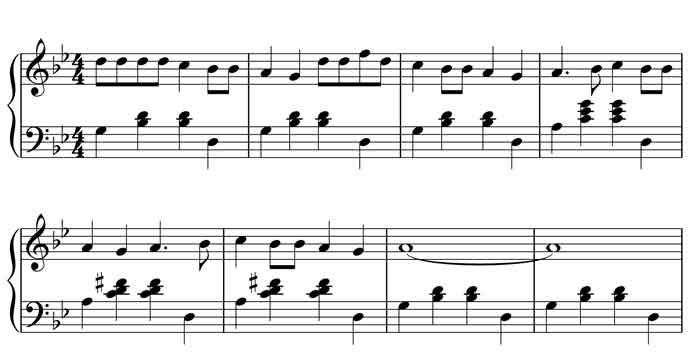 This melody is not original to the film, but taken from the Russian folk song, “The Birch Tree”. In the film, it is generally associated with Konstantin Levin, the wealthy land-owner who is in love with Princess Kitty and desires to live less like an aristocrat and more like the peasant folk of Russia. But the theme also appears in several instances with Stiva (Anna’s brother), whom Levin consults for advice a couple of times. The theme therefore has two functions. On the one hand, it represents the comical relationship between Levin and Stiva, and when we hear it during their meets, it is in a staccato rhythmic dance-like style that gives it a sense of levity. On the other hand, it also represents Levin’s desire for the humbler peasant lifestyle, and so in scenes that depict this, we hear more serious versions of the theme. When Levin is harvesting the grass for haymaking with his workers, for instance, the theme is sung with its Russian text.
This melody is not original to the film, but taken from the Russian folk song, “The Birch Tree”. In the film, it is generally associated with Konstantin Levin, the wealthy land-owner who is in love with Princess Kitty and desires to live less like an aristocrat and more like the peasant folk of Russia. But the theme also appears in several instances with Stiva (Anna’s brother), whom Levin consults for advice a couple of times. The theme therefore has two functions. On the one hand, it represents the comical relationship between Levin and Stiva, and when we hear it during their meets, it is in a staccato rhythmic dance-like style that gives it a sense of levity. On the other hand, it also represents Levin’s desire for the humbler peasant lifestyle, and so in scenes that depict this, we hear more serious versions of the theme. When Levin is harvesting the grass for haymaking with his workers, for instance, the theme is sung with its Russian text.
Compare two examples below:
“Lament 1” and “Lament 2”
Lament 1
Lament 2
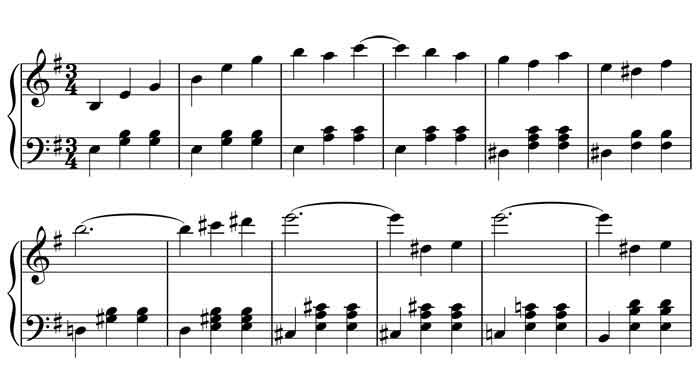 The lament-like quality of these themes is evident in their minor key and bass line. Notice especially in both of the examples above that the bass steps down in semitones from the tonic to the dominant over the two lines shown. (They actually have exactly the same chordal structure). In classical music, this is known as the “lament” bass line because it is associated with the expression of deep grief, the best-known example being “Dido’s Lament” from Purcell’s opera Dido and Aeneas:
The lament-like quality of these themes is evident in their minor key and bass line. Notice especially in both of the examples above that the bass steps down in semitones from the tonic to the dominant over the two lines shown. (They actually have exactly the same chordal structure). In classical music, this is known as the “lament” bass line because it is associated with the expression of deep grief, the best-known example being “Dido’s Lament” from Purcell’s opera Dido and Aeneas:
Neither of these themes is associated with a single character. Instead, they signify more generally the negative emotions of the character onscreen or that the character is entering into a dangerous situation. When Kitty, for example, arrives at the dance near the start of the film, we hear “Lament 1” because she is actively seeking the affections of Vronsky, whose relationship with Anna eventually leads to Anna’s death. But we also hear the theme just after Anna has been virtually ignored at a coffeehouse due to her infidelity and is quickly realizing the limitations her affair and separation cause her in society. Here’s the theme as we hear it with Kitty at the dance (from 0:07):
“Lament 2” is usually bound together with “Lament 1”, which demonstrates one of Marianelli’s unique talents—the combination of different melodies together in harmonious counterpoint. In Kitty’s arrival at the dance, for instance, after hearing “Lament 1” alone, it occurs together with “Lament 2” as she enters the dance floor and hence comes nearer to Vronsky. Hear this in the clip above at 0:27.
“Lament 1” is also frequently heard together with “Anna’s Love”, a combination that aptly reflects the danger that Anna causes herself through her love of Vronsky. When Anna, for example, arrives late at a soiree and realizes she has missed Vronsky, we hear “Lament 1”. But when Vronsky turns his carriage around to return to the party and meet Anna again, we hear “Lament 1” in the cello combined with “Anna’s Love” in the violin to suggest the ill consequences Anna’s love of Vronsky will have on her. Hear this below at 0:17:
The Film’s “Overture”
Director Joe Wright’s artistic take on Anna Karenina presents most of the story inside a theatre that is not visible to the characters. Thus, much of the film has a stagey feel, something like an opera. In fact, Vronsky himself says to Anna at the first ball that “if I’m not to dance with you, I’m getting out of this operetta and going home.” This operatic style is enhanced by the music of the opening montage, which essentially acts as an operatic overture. While the narrative is unfolding during this overture (which is not common practice in opera), the music presents most of the themes described above several times. In this way, the audience not only becomes familiar with the film’s major musical themes, but also obtains a loose sense of what those themes might represent. The score therefore achieves somewhat more than the typical opera overture (or main title music, for that matter) and does so in a highly creative way.
Given below are an audio clip of the overture and the themes heard in the overture along with a description of what is shown onscreen. Because the overture alternates the Levin/Stiva theme with other material (either Anna’s Love or Lament 1), it obtains a musical structure that does not necessarily agree with the images shown.
- Levin/Stiva – Opening titles on curtain
- Anna’s Love – Stiva’s face becomes clear
- Levin/Stiva + Countermelody – Stiva’s wife
- Anna’s Love – Anna reads letter from Stiva
- Levin/Stiva – Stiva saying goodbye to daughter for the day with governess in room
- Lament 1 – Stiva emerges from closet after making love to governess, then we see his wife in tears with his love letters
- Levin/Stiva– Stage changes scenery to the Karenin household
Coming soon—who will likely win the Best Original Score Oscar and why. Stay tuned…
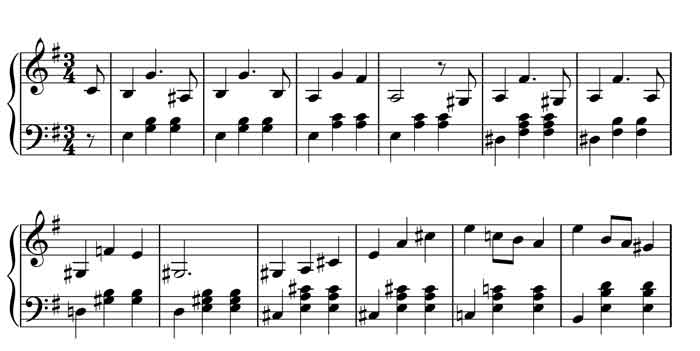
A beautiful score indeed. Thanks for this!
very fantastic music